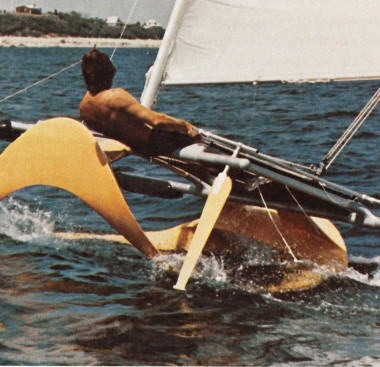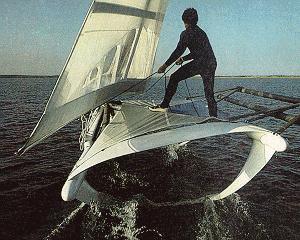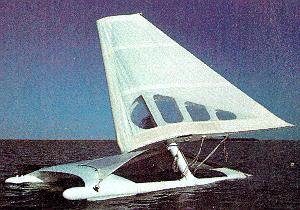Hydrofoils on proas
This is Patrick Cudmore’s Seaflier, a solid wing, canted rig, hydrofoil proa built in 1984.
Neither hydrofoil sailboats nor canted rigs are particularly new, but Cudmore’s lightweight proa-configured craft with its cantilevered, articulating wingsall and inverted, elliptical arch, surface-piercing foils offers a glimpse of a future made possible by sophisticated design and strong but light composite plastics. -Keith Taylor, SAIL magazine
That was in 1984. Before that, Bernard Smith developed the Aerohydrofoil, a sailing hydrofoil based on the proa configuration. Proas and hydrofoils, they just go together. Combine the most efficient plan with the most efficient foils and you get record-breaking speed, from Crossbow to Yellow Pages Endeavor to Sailrocket.
And yet, all the modern big money hydrofoils are bilaterally symmetrical. What the hell happened?
Computers. I blame them. Hydrofoil sailboats require Fluid Dynamics software, which are based upon data gathered for airplane foils by NACA (now NASA) and there are no proa airplanes (Burt Rutan’s Boomerang not withstanding). No research done on optimizing foils that must operate within a reversing flow, no data, no software, no proas.
If an item does not occur in our records, it does not exist. -Star Wars
However, there is still, one hope in the sea of bilateral conformity. Boeing aeronautical engineer Tom Speer has created a foil section optimized for reversing flow. It may not be the Holy Grail of proa foil sections, but it puts us in the ball park. Imagine bi-directional sails, together with bi-directional hydrofoils - it becomes a simple package with a common simple theme running right the way through it. It has an elegance to it. Nothing would be an optimally efficient foil (hulls, sails and foils) but the combined effect of it could be startling in action…
With this section, go forth, and conquer.




